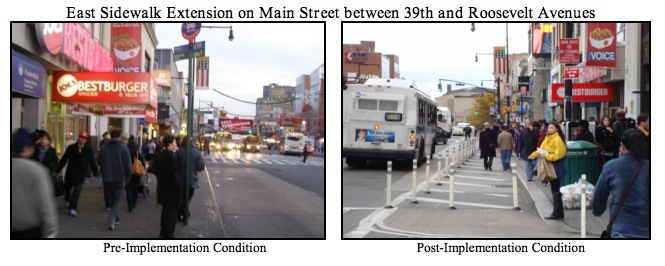
It might not be as bold or attention-grabbing as the overhaul of Times Square and Herald Square, but a set of changes made to New York City's third-busiest pedestrian intersection is having its own quiet success. In Downtown Flushing, a 2010 project that expanded sidewalks, daylighted dangerous intersections, and introduced numerous turn restrictions is boosting safety even while traffic flows more smoothly, according to a new evaluation from NYC DOT [PDF].
Downtown Flushing's streets needed an upgrade perhaps more than anywhere else in Queens. The Main Street subway station, fed by 21 bus routes, is the busiest outside Manhattan. In one 12-hour period, DOT counted 97,000 pedestrians on a single block of Main Street. And in 2009, more pedestrians were hit by cars at the corner of Union Street and Northern Boulevard than any other location in the borough.
Few of the changes installed by DOT in July of 2010 reshaped the street, but together, they have noticeably improved how the area's transportation system functions. In four locations, DOT used paint and bollards to expand the sidewalk, creating 700 square feet of new pedestrian space. At seven locations, parking spaces were removed to daylight intersections and improve visibility. New turn restrictions at five intersections reduced conflicts between automobiles and pedestrians crossing the street, but buses are allowed through at certain locations.
The overall safety effect has been substantial, according to DOT's recently released evaluation. Crashes with injuries declined by 20 percent in the study area (Prince Street to Bowne Street, 35th Avenue to Sanford Avenue). Total injuries fell by 29 percent. Drivers and their passengers benefited the most from the safety gains, with injuries falling by more than a half. The improvement to pedestrian safety was more modest, with only an eight percent reduction.
The safety upgrades didn't delay bus riders or motorists, either. The level of service -- a measure of congestion that is often used to justify widening roads and otherwise degrade the pedestrian environment -- improved at nine out of 19 intersections studied and remained unchanged elsewhere. Average traffic speeds increased on almost all of Flushing's clogged streets.
There's much more that can be done for this critical transit and pedestrian hub, however. Safety is still a major concern. Two weeks ago, two pedestrians were struck and killed by drivers in Downtown Flushing in just two days. And anyone who's walked in the neighborhood knows that the sidewalks remain full to bursting. With its overflowing pedestrian corridors and high-volume transit network, the heart of Flushing needs the kind of change that DOT has brought to the heart of Manhattan: bold commitments to bettering the public realm.





